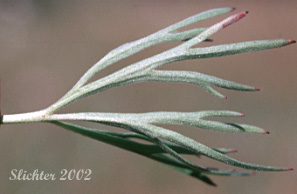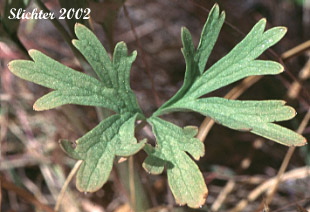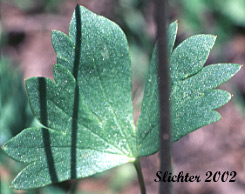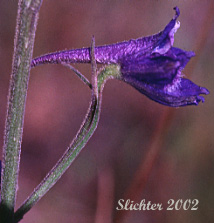 The
photo at right shows meadow larkspur as seen along US 97 through the Yakima Indian
Reservation in south-central Washington. Note the dense cluster of stem leaves
below the inflorescence...........June 22, 1997.
The
photo at right shows meadow larkspur as seen along US 97 through the Yakima Indian
Reservation in south-central Washington. Note the dense cluster of stem leaves
below the inflorescence...........June 22, 1997.
Meadow larkspur is an attractive perennial wildflower with one or occasionally several erect, leafy stems arising 40-70 cm high from a cluster of fleshy roots. The herbage consists of a dense minute pubescence and occasionally some glandular hairs above. The stems are generally not hollow. The basal and stem leaves both appear different. Both have petioles at least equaling the length of the blade. The lower leaf blades range from 4-6 cm wide and are divided into 3 broad segments which are twice dissected into wide lobes. The leaves of midstem are very numerous and overlap each other. The petioles are short and hold the blades erect and near the stem. Their blades are finely dissected into linear segments. The basal leaves generally have dried by flowering time.
The inflorescence is a dense spike (simple to compound) of many closely spaced flowers. The calyx is bright blue, the oblong sepals about 1 cm long and much shorter than the straight spur. The sepals are cupped forward rather than flared to the sides. The lower petals are blue and long-hairy, lobed about 1/3 their length. The upper petals are a pale blue or almost white. The pedicels are shorter than the spur(which ranges from 11-17 mm long) and strongly ascending.
Meadow larkspur is found in vernally moist areas such as swales and wet meadows in both sagebrush or ponderosa pine forest. It frequently is found at springs which dry up by summertime.
Meadow larkspur may be found east of the Cascade Mt. crest from British Columbia south to the Columbia River and east to Idaho and north central and northeastern Oregon.
The photo at left shows a close-up of the inflorescence of meadow larkspur along a vernal stream at Brooks Memorial State Park.....June 4, 2021. Meadow larkspur as seen at center in the upper Naneum Creek drainage, Wenatchee National Forest...........July 2009. The photo at right shows the inflorescence of meadow larkspur as seen along the Stubblefield Trail, Turnbull National Wildlife Refuge.......July 4, 2018.



